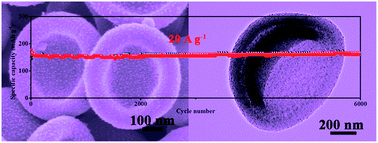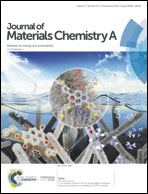The general construction of asymmetric bowl-like hollow nanostructures by grafting carbon-sheathed ultrasmall iron-based compounds onto carbon surfaces for use as superior anodes for sodium-ion hybrid capacitors†
Abstract
The lack of appropriate anode candidates displaying ultrafast sodium insertion/extraction capabilities to match the capacitive behavior of cathodes has become a very challenging issue. In the current work, we developed a feasible yet general strategy to construct novel bowl-like hollow particles with dual-carbon protection consisting of ultrasmall iron-based-compound nanodots embedded into a carbon matrix (denoted as C@FeX, X = O/S/Se/P). The bowl-like C@Fe–X exhibited superior sodium ion storage, in particular high specific capacity and excellent cycling stability and rate capabilities, when evaluated as an anode. Specifically, the bowl-like hollow C@FeSe2 particles delivered excellent cycling stability with negligible fading of capacity under a high rate of 20 A g−1 for 6000 cycles, and maintained 42.0% of the initial specific capacity with the current density ranging from 0.1 to 20 A g−1. More importantly, the NIHCs based on the anode made of the bowl-like C@FeP particles showed a high energy density of 133.6 W h kg−1 at a power density of 200 W kg−1, demonstrating great potential for practical applications.



 Please wait while we load your content...
Please wait while we load your content...